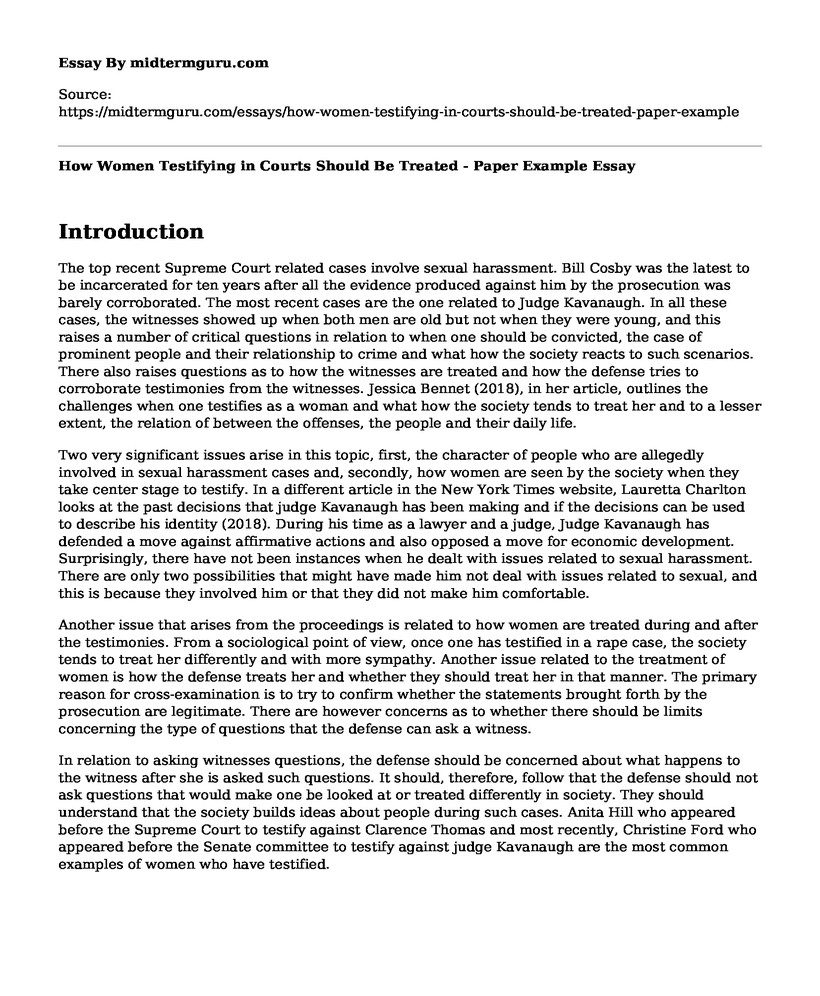Introduction
The top recent Supreme Court related cases involve sexual harassment. Bill Cosby was the latest to be incarcerated for ten years after all the evidence produced against him by the prosecution was barely corroborated. The most recent cases are the one related to Judge Kavanaugh. In all these cases, the witnesses showed up when both men are old but not when they were young, and this raises a number of critical questions in relation to when one should be convicted, the case of prominent people and their relationship to crime and what how the society reacts to such scenarios. There also raises questions as to how the witnesses are treated and how the defense tries to corroborate testimonies from the witnesses. Jessica Bennet (2018), in her article, outlines the challenges when one testifies as a woman and what how the society tends to treat her and to a lesser extent, the relation of between the offenses, the people and their daily life.
Two very significant issues arise in this topic, first, the character of people who are allegedly involved in sexual harassment cases and, secondly, how women are seen by the society when they take center stage to testify. In a different article in the New York Times website, Lauretta Charlton looks at the past decisions that judge Kavanaugh has been making and if the decisions can be used to describe his identity (2018). During his time as a lawyer and a judge, Judge Kavanaugh has defended a move against affirmative actions and also opposed a move for economic development. Surprisingly, there have not been instances when he dealt with issues related to sexual harassment. There are only two possibilities that might have made him not deal with issues related to sexual, and this is because they involved him or that they did not make him comfortable.
Another issue that arises from the proceedings is related to how women are treated during and after the testimonies. From a sociological point of view, once one has testified in a rape case, the society tends to treat her differently and with more sympathy. Another issue related to the treatment of women is how the defense treats her and whether they should treat her in that manner. The primary reason for cross-examination is to try to confirm whether the statements brought forth by the prosecution are legitimate. There are however concerns as to whether there should be limits concerning the type of questions that the defense can ask a witness.
In relation to asking witnesses questions, the defense should be concerned about what happens to the witness after she is asked such questions. It should, therefore, follow that the defense should not ask questions that would make one be looked at or treated differently in society. They should understand that the society builds ideas about people during such cases. Anita Hill who appeared before the Supreme Court to testify against Clarence Thomas and most recently, Christine Ford who appeared before the Senate committee to testify against judge Kavanaugh are the most common examples of women who have testified.
Conclusion
From the above discussion, it is therefore evident that women rarely testify because of the social stigma that meets them after such instances (Hammond, and Kingston, 2014). On the other hand, it is also evident that people rarely deal with issues that affect them. By trying to campaign against the social stigma, then the society would work towards eradicating the instances of abuse of power and office.
References
Bennett, J. (2018). The 'Tight Rope' of Testifying While Female. Retrieved from https://www.nytimes.com/2018/09/28/us/politics/christine-blasey-ford-testimony-testifying-while-female.html?rref=collection%2Ftimestopic%2FRace%20and%20Ethnicity&action=click&contentCollection=timestopics®ion=stream&module=stream_unit&version=latest&contentPlacement=3&pgtype=collection
Charlton, L. (2018). What to Know About Kavanaugh's Record on Civil Rights. Retrieved from https://www.nytimes.com/2018/09/06/us/kavanaugh-civil-rights-race-hearing.html?rref=collection%2Ftimestopic%2FRace%20and%20Ethnicity&action=click&contentCollection=timestopics®ion=stream&module=stream_unit&version=latest&contentPlacement=24&pgtype=collection
Hammond, N., & Kingston, S. (2014). Experiencing stigma as sex work researchers in professional and personal lives. Sexualities, 17(3), 329-347.
Cite this page
How Women Testifying in Courts Should Be Treated - Paper Example. (2022, Sep 06). Retrieved from https://midtermguru.com/essays/how-women-testifying-in-courts-should-be-treated-paper-example
If you are the original author of this essay and no longer wish to have it published on the midtermguru.com website, please click below to request its removal:
- Literature Essay on The Canterbury Tales: Courtly Love in The Knights Tale
- The Role of Evidence in Forensic Science: Paper Example
- Juvenile Crime Rate Paper Example
- Paper Example on International Humanitarian and Human Rights Laws
- How Sex Workers Human Rights Are Being Violated Around the World? - Paper Example
- Theoretical Perspective Explaining White Collar Crime
- Attention Deficit Hyperactivity Disorder and Criminality Continued Care - Research Paper







